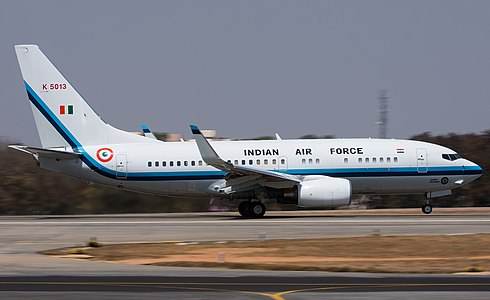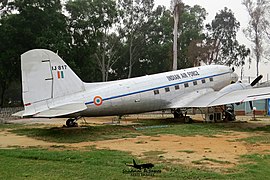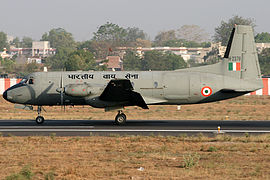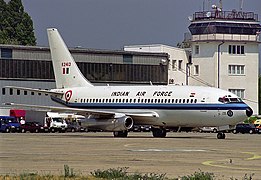Air HQ Communication Squadron, Indian Air Force
| Air HQ Communication Squadron | |
|---|---|
| Active | 1 November 1947–present |
| Country | |
| Branch | |
| Role | VVIP transport Special Air Missions Airlift |
| Garrison/HQ | Air Force Station Palam, New Delhi |
| Nickname(s) | "Pegasus" |
| Motto(s) | Seva aur Suraksha Service and Security |
| Commanders | |
| Current commander | Group Captain Saurav Shiv |
| Notable commanders | First: Squadron Leader Melville Duarte (01 Nov 1947 – 22 Sep 1948) |
| Aircraft flown | |
| Transport | 2 Boeing 777-300ER 3 Boeing 737 BBJ 4 Embraer 145 4 Embraer 135BJ 5 Mi-17 V-5 helicopters |
The Air Headquarters Communication Squadron (Pegasus) (AHQCS) of the Indian Air Force is based at Air Force Station Palam, New Delhi. [1] The Air Headquarters Communication Squadron is a transport squadron which maintains a fleet of aircraft with the primary aim of providing air transport to the President, Vice President and Prime Minister of India, within and outside the country, and to visiting foreign heads of State, categorized as VVIPs.[2]
Components[edit]
The squadron is commanded by an officer of the rank of Group Captain, who is also responsible for operation of VIP aircraft and their maintenance. It operates under the functional and administrative control of the Directorate of Operations (VIP) at Air Force Headquarters through 3 Wing AF at Palam.[3]
The Ministry of Defence regulates the special flights and stipulates as per relevant orders that, with the exception of the President, Vice President and Prime Minister, certain 'other entitled persons' (OEP) can also avail special flights. This includes and is limited to: Minister of Defence, Minister of Home Affairs, Minister of State in the Ministry of Defence, Chiefs of the three Defence Services, Defence Secretary, other Cabinet Ministers, Senior Service and Civilian Officers who are connected with Defence Organisation and Cabinet Secretary.[3]
History[edit]
This section needs expansion. You can help by adding to it. (September 2021) |
Due to the requirement of conveying VIPs in pre-Independence India, a small unit was formed in January 1947 under Wing Commander Bryant Fenner of the Royal Indian Air Force (RIAF) called Communication Squadron (India). This unit came under the command of Squadron Leader Melville Duarte on 1 November 1947 as Air Headquarters Communication Squadron (RIAF) and has been based at Air Force Station Palam ever since. It retained its name after India became a republic on 26 January 1950.[4]
The squadron began operations with war-surplus Airspeed Oxford and Douglas C-47 Skytrain (Dakota) aircraft.[5] It acquired the DeHavilland Dove the following year.[6] The first turboprop aircraft, two Vickers Viscount, were inducted in 1956, but were withdrawn from service and sold in 1967.[7] During his premiership, Prime Minister Jawaharlal Nehru and his family occasionally flew in a VIP Dakota, IJ-817-S, from which his ashes were scattered in the Vale of Kashmir following his death in May 1964.[8]
In 1964, the squadron acquired the Hawker Siddeley HS 748 (Avro), followed by the induction of three VIP variants of the Tupolev Tu-124 in 1966.[5] On 4 November 1977, one of the three TU-124 aircraft (V-643), carrying Prime Minister Morarji Desai and other officials from Delhi to Jorhat, struck trees during its landing approach and crashed with the loss of the crew, though the Prime Minister and the other passengers survived. A subsequent court of inquiry attributed the cause of the accident to a combination of spatial disorientation and pilot error, with the possible failure of a radio-altimeter as a factor.[9] The last of the three TU-124s, Rajdoot, was retired on 13 November 1981, having been replaced by the Boeing 737-200 in October 1980.[10]
Fleet[edit]
Boeing 777-300ER (Air India One)
In October 2020, two fully customized Boeing 777-300ER aircraft were inducted into the squadron at a cost of ₹8,458 Crore.[11] Prior to this, two Air India operated Boeing 747-400s were being used for VVIP overseas transport.[12] The two ex- Air India 777 aircraft underwent major modifications at Boeing's facility in Fort Worth, Texas, where they were fitted with missile defence and communications systems requisite of aircraft conveying Heads of State and Heads of Government.[13]
Each aircraft features a VVIP suite, two conference rooms, a press briefing room, a medical room and secure communications system, with jammers.[14]
The new aircraft was utilized for the first time on 26 March 2021 during the Indian Prime Minister's visit to Dhaka, Bangladesh.[15]
Aircraft operating VVIP flights are designated Special Extra Section Flight (SESF).[16] On SESF missions, the President is designated as VIP-1, the Vice President as VIP-2, and the Prime Minister as VIP-3. On official mission with any of three VIPs on board, the aircraft are designated the callsign Air India One.
While Union Ministers and senior staff officers of the Indian Armed Forces may use smaller aircraft for official travel, the B777-300ER's are exclusively used by the President, Vice President and Prime Minister.
Passengers traveling on board Air India One are required to wear colour-coded identity cards at all times. Members of the official delegation (rank of Joint Secretary to the Government of India and above) are tagged in purple and sit in first class equivalent seats. Personnel of the Special Protection Group are also tagged in purple since they provide proximate security to the Prime Minister, and may carry close combat weapons for the duration of flights. Accompanying officials (passengers of rank below Joint Secretary) are tagged in pink, and sit in business class equivalent seats. Support staff, including cooks and butlers, and other security personnel (not including the Special Protection Group) are tagged in red, while journalists in the press pool are tagged in yellow. Both red and yellow-tagged passengers sit in economy class equivalent seats.[17]
The B777-300ER's onboard electronics include about 238 miles of wiring (twice the amount found in a normal 777). Heavy shielding is tough enough to protect the wiring and crucial electronics from the electromagnetic pulse associated with a nuclear blast.[18] The aircraft is fitted with encrypted satellite communication facilities and advanced navigation aids, an advanced missile warning system, a missile deflecting shield and electronic countermeasures so as to provide protection from any ground-based or airborne threats.
The B777-300ERs are military vessels formally owned by the Indian Air Force. They bear no Air India markings and will not have commercial dual-use. However, under a special contract, their maintenance will be carried out by Air India Engineering Services Limited (AIESL),[16] which has experience in maintaining the Boeing 777 series aircraft for Air India's commercial fleet.
Boeing 737
In 2009, three customized 46 seater Boeing Business Jets (BBJ) (737-7HI) with advanced defensive features similar to the U.S. Air Force One replaced the former ageing Boeing 737-200 aircraft.[19] The three BBJs, named Rajdoot, Rajhans and Rajkamal were procured at a cost of ₹9.34 billion (US$130 million) each - ₹7.34 billion (US$100 million) for the actual aircraft plus an additional ₹2 billion (US$28 million) for Self Protection Suites. These suites include radar warning receivers, missile-approach warning and counter-measure systems. The aircraft has the capability to shoot chaff and flares to deviate radar-guided and heat-seeking missiles off their target path. Other security instruments on board the aircraft are classified.
The BBJs have a four class configuration. For VIPs 1, 2 and 3, an executive enclosure in the aircraft includes an office and a bedroom.
Embraer 145 and Legacy 600
From 21 September 2005, four 14 seater Embraer Legacy 600 and four 20 seater Embraer 145 aircraft[20] were inducted into the squadron to replace the HS-748 Avro transports.[21] Each Embraer 135 is equipped with missile-deflecting systems, modern flight management systems including global positioning system configuration, as well as category II instrument landing system. These aircraft cost the IAF ₹1.4 billion (US$20 million) each.
Mil Mi-17 V-5
The Mil Mi-17 V-5 is currently used to ferry VVIPs and OEPs within the country. The old and ageing Mi-8 helicopters were retired in 2017[22] and replaced with the newer, more advanced Mi-17 V-5 helicopters.[23]
In February 2010, the UPA-led government had signed a contract worth €556 million for 12 new AgustaWestland AW-101 helicopters for VVIP transport. This deal was scrapped by the NDA-led government in January 2014, on allegations of bribery.[24] In 2014, approval was given by the Ministry of Defence for the "conversion" of six [military] Mi-17 V-5s to VVIP helicopters, to replace the old Mi-8s. The conversion was carried out at the IAF base repair depot (3 BRD), Chandigarh.[24]
On 8 December 2021, a Mi-17 V-5 was lost in an incident in the Nilgiri hills in Tamil Nadu. The helicopter carrying Chief of Defence Staff General Bipin Rawat, his wife and other military personnel crashed near Coonoor while flying from Sulur Air Force Station, Coimbatore to Wellington where the CDS was scheduled to visit the Defence Services Staff College. General Rawat, his wife and all except one of the 14 personnel on board the helicopter were killed.[25] A week later, one of the pilots, the lone survivor of the crash, succumbed to his injuries in hospital.[26]
-
IAF Boeing 777-300ER Special Extra Section Flight
-
IAF Boeing 737 BBJ 'Rajhans'
-
IAF Embraer Legacy 600 (Embraer 135BJ) 'Gagandoot'
-
IAF Mil Mi-17 helicopter (combat version)
Historical fleet[edit]
- Airspeed Oxford (1947–48)
- North American Harvard (variant of the North American T-6 Texan) (1947–68)
- Douglas DC-3 (1948–67)
- De Havilland Devon (1948–78)
- Ilyushin Il-14 (1955–67)
- Vickers Viscount (1956–62)
- De Havilland Vampire (1956–62)
- Hawker Siddeley HS-748 Avro (1964-2005)
- Tupolev Tu-124 (1966–81)
- Boeing 737-200 (1983-2009)
- Mil Mi-8 (1983-2017)
-
IAF Douglas DC-3 Dakota
-
Indian Air Force Historic Flight Douglas DC-3 Dakota
-
IAF DeHavilland Vampire
-
IAF Hawker Siddeley HS-748 Avro
-
IAF Tupolev Tu-124
-
IAF Boeing 737-200 'Rajdoot'
-
IAF Mil Mi-8 helicopter
See also[edit]
- Air India One
- 89th Airlift Wing - United States Air Force
References[edit]
- ^ "Squadrons and Helicopter Units". Bharat Rakshak. Archived from the original on 14 April 2015. Retrieved 4 December 2015.
- ^ "AirHQ Communications Squadron, Indian Air Force - Database". Bharat Rakshak. Retrieved 24 September 2021.
- ^ a b Audit of Air HQ Communication Squadron, Comptroller and Auditor General of India report, 2006
- ^ "Air HQ Communication Squadron". www.globalsecurity.org. Retrieved 24 September 2021.
- ^ a b "VIP Squadron of Air Force Celebrates 33rd Anniversary" (PDF). Press Information Bureau of India - Archive. 17 November 1980. Retrieved 21 November 2020.
- ^ "Air Headquarters Communication Squadron" (PDF). Press Information Bureau of India - Archive. 7 December 1984. Retrieved 21 November 2020.
- ^ Turner, P. St. John (1968). Handbook of the Vickers Viscount. London: Ian Allan Publishing. p. 149. ISBN 978-0711000520.
- ^ "The Late Prime Minister Nehru's Ashes Scattered from the Air" (PDF). Press Information Bureau of India - Archive. 12 June 1964. Retrieved 21 November 2020.
- ^ "Regarding the Air Accident at Jorhat on 4 November 1977 to TU-124 Aircraft Carrying the Prime Minister" (PDF). Press Information Bureau of India - Archive. 10 May 1978. Retrieved 21 November 2020.
- ^ "Last of the TU-124 Fleet Bows Out of Indian Air Force" (PDF). Press Information Bureau of India - Archive. 13 November 1981. Retrieved 21 November 2020.
- ^ "Air India One: What is so special about PM Narendra Modi's new VVIP Hightech aircraft". DNA India. 1 October 2020. Retrieved 26 September 2021.
- ^ Torkham, Sulabha (2 October 2020). "How India's VVIP aircraft Air India One is different from its predecessor Boeing 747". India Today. Retrieved 24 September 2021.
- ^ "Air India One: Second VVIP aircraft in Prime Minister and President's fleet arrives in Delhi". Hindustan Times. 25 October 2020. Retrieved 24 September 2021.
- ^ Saha, Poulomi (25 October 2020). "Exclusive: Inside Boeing's Air India One bought for VVIPs, including PM, President". India Today. Archived from the original on 29 October 2020. Retrieved 24 September 2021.
- ^ "Bangladesh visit PM uses new VVIP aircraft for 1st time on foreign trip". The Week. Retrieved 24 September 2021.
- ^ a b "Contingents of Air India, IAF, govt officials and security personnel leave for US to collect VVIP aircraft 'Air India One'". ANI News. Retrieved 24 September 2021.
- ^ Nayyar, Dhiraj (26 September 2010). "Air India One, Seat No 59G - Indian Express". Indian Express. Retrieved 4 October 2020.
- ^ "Know about Air India One! (Air Air India One – AI 1)". Aviation Thrust. Retrieved 19 November 2015.
- ^ Krishnaswamy, Murali N. (24 March 2011). "A command post in the air". The Hindu. Retrieved 21 November 2020.
- ^ "VVIPs get their special jets". 21 September 2005. Retrieved 8 April 2011.
- ^ Pandey, B.K. (2020). "15 years' legacy with the IAF". SP's Aviation. Retrieved 21 November 2020.
- ^ "Aircraft Fleet Strength". www.bharat-rakshak.com. Retrieved 25 September 2021.
- ^ "Mi-17V-5 Military Transport Helicopter". www.airforce-technology.com. Retrieved 25 September 2021.
- ^ a b Pandit, Rajat. "Choppergate effect: Upgraded Mi-17 V5s to ferry President, Prime Minister". The Economic Times. Retrieved 25 September 2021.
- ^ "Bipin Rawat: Tributes for India's top general who died in helicopter crash". BBC News. 9 December 2021. Retrieved 9 December 2021.
- ^ Ranjan, Abhinav (15 December 2021). "Group Captain Varun Singh, lone survivor of IAF's helicopter crash in Tamil Nadu, succumbs to injuries". www.indiatvnews.com. Retrieved 15 December 2021.











